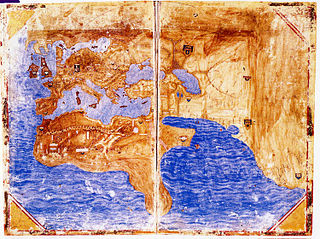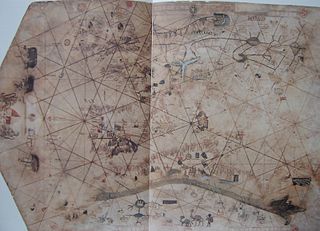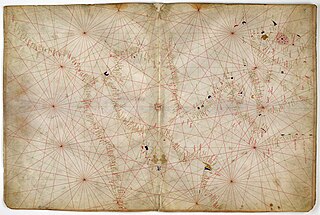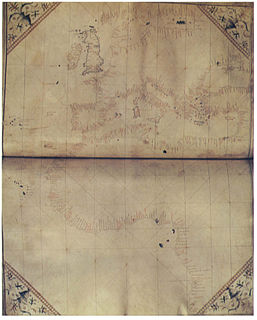
Visconte Maggiolo, also spelled Maiollo and Maiolo, was an Italian cartographer and sailor.
Angelino Dulcert, probably also the same person known as Angelino de Dalorto, and whose real name was probably Angelino de Dulceto or Dulceti or possibly Angelí Dolcet, was an Italian-Majorcan cartographer.

Abraham Cresques, whose real name was Cresques (son of) Abraham, was a 14th-century Jewish cartographer from Palma, Majorca. In collaboration with his son, Jehuda Cresques, Cresques is credited with the authorship of the celebrated Catalan Atlas of 1375.

Battista Agnese was a cartographer from the Republic of Genoa, who worked in the Venetian Republic.

The maritime republics of the Mediterranean Basin were thalassocratic city-states which flourished in Italy and Dalmatia during the Middle Ages. The best known among the maritime republics are Venice, Genoa, Pisa, and Amalfi. Less known are Ragusa, Gaeta, Ancona, and Noli.

"Majorcan cartographic school" is the term coined by historians to refer to the collection of predominantly Jewish cartographers, cosmographers and navigational instrument-makers and some Christian associates that flourished in Majorca in the 13th, 14th and 15th centuries until the expulsion of the Jews. The label is usually inclusive of those who worked in Catalonia. The Majorcan school is frequently contrasted with the contemporary Italian cartography school.

The Carta Pisana is a map probably made at the end of the 13th century, about 1275-1300. New research suggests that it was made a century later. It was found in Pisa, hence its name. It shows the whole Mediterranean, the Black Sea and a part of the atlantic coast, from the north of present-day Morocco to the present-day Netherlands, but the accuracy of the map is mostly limited to the Mediterranean. It is the oldest surviving nautical chart. It is a portolan chart, showing a detailed survey of the coasts, and many ports, but bears no indication on the topography or toponymy of the inland. On the map, North is on the top, in contrast to other maps of the same period such as the Hereford Mappa Mundi, where East is on the top.

Giovanni da Carignano, or Johannes de Mauro de Carignano was a priest and a pioneering cartographer from Genoa.
Domenico and Francesco Pizzigano, known as the Pizzigani brothers, were 14th-century Venetian cartographers. Their surname is sometimes given as Pizigano in older sources.

The Medici-Laurentian Atlas, also known simply as the Medici Atlas, is an anonymous 14th-century set of maps, probably composed by a Genoese cartographer and explicitly dated 1351, although most historians believe it was composed, or at least retouched, later. The atlas is currently held by the Biblioteca Medicea Laurenziana in Florence, Italy.

Guillem Soler, sometimes given as Guillelmus Soleri, Guillermo Soler and Guglielmo Soleri, was a Majorcan cartographer of the 15th century.

Battista Beccario, also known as Baptista Beccharius, was a 15th-century Genoese cartographer.
The Corbitis Atlas is a late 14th-century atlas of four portolan charts, composed by an anonymous Venetian cartographer, and currently held by the Biblioteca Nazionale Marciana in Venice, Italy.

The Pinelli–Walckenaer Atlas is a late 14th-century atlas of portolan charts, explicitly dated 1384, primarily composed by an anonymous Venetian cartographer, and held by the British Library.

The Bodleian-Douce Atlas is an early 15th-century nautical atlas by an anonymous Italian cartographer, currently held by the Bodleian Library in Oxford, UK.

The Cornaro Atlas is an extensive Venetian collection of nautical charts and tracts, currently held by the British Library.
A rutter is a mariner's handbook of written sailing directions. Before the advent of nautical charts, rutters were the primary store of geographic information for maritime navigation.
























